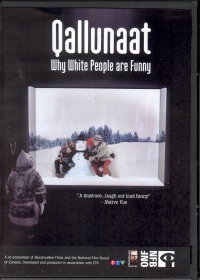| ________________
CM . . .
. Volume XIV Number 12 . . . .February 8, 2008 
 |
Qallunaat! Why White People Are Funny.
Mark Sandiford (Writer & Director). Mark Sandiford & Kent Martin (Producers).
Montreal, PQ: National Film Board of Canada, 2006.
98 min., 54 sec., VHS or DVD, $99.95.
Order Number: 153C 0107 132.
Subject Headings:
Inuit-Attitudes.
Whites-Canada, Northern-Public Opinion.
Whites-Canada, Northern-Relations with Indians.
Grades 7 and up / Ages 12 and up.
Review by Keith McPherson.
**** /4
|
| |
|

Using the same scientific techniques that white people (Qallunaats) have used to investigate the Inuit culture, Qallunologists (Inuit scientists) turn their investigative lens towards discovering the 'ins' and 'outs' of white man's culture. Although their findings are presented with humour and sharp wit, the underlying message is a sobering critical reflection into past and present racial prejudices, discrimination, and hegemonic social pillaging that European colonial domination has wrought upon Inuit culture.
Constructed fictitious scientific explorations of Qallunaat are conducted at the Qallunaat Studies Institute (QSI). These explorations are effectively woven together with candid interviews with Inuit, and with historical black and white footage of Inuit tribal practices, first contact with white men, and white man's inculturalization practices. The resulting 'scientific insights' emphasize how white men have a history of treating Inuit with indifference, appropriating Inuit land, assimilating Inuit culture through public schooling, and how they have attempted to replace the Inuit's oral processes of thinking and socializing with Qallunaat's writing processes. One Inuit interviewee, John Amagoalik, summed up the goal of white man's domineering contact with Inuit when he said that "white man's government and police always expected to have their way."
Furthermore the QSI's exploration into the lives of white men finds Qallunaats to be less civilized than expected. For example, QSI concludes that "white people smell like antiseptic soap," "they are linguistically confusing," and they are bumbling explorers who are "accidents waiting to happen." Many Qallunaats may find it difficult to swallow these conclusions, further highlighting how uncomfortable it must be to be a member of another culture, like the Inuit, being scrutinized and judged under the guise of 'white man's science.'
The film is 98.54 minutes long and is broken into two segments. 38 minutes for the feature film, and 50 minutes for the conference. The conference is very long and repetitive of a great deal of information from the feature film. The feature definitely is the stronger presentation of the two segments, although it could have used tighter editing in areas like the Qallunaat's bumbling forays into the arctic so as to bring the film under a half and hour.
Criticism may be leveled at the filmmakers' integration of historical film with current Inuit practices and lifestyles. Some may even call for the separation of the feature film into two distinct films – a historical account of Inuit/Qallunaat relations, and a current account. I would disagree. The film wouldn't hold the punch that it does if past practices of oppression and discrimination are not visually juxtaposed against their effects on current Inuit lifestyle and perceptions. For example, the segment of historical film showing a young Inuit boy learning to read 'Dick and Jane' is essential visual background for understanding the very uncomfortable position a Qallunaat teachers finds himself in when, 50 years later, his Inuit student questions the significance of a white man's education on a Inuit child's development.
The cinematic techniques employed in Qallunaat: Why White People are Funny are varied and can be used by teachers and students wishing to explore the process and argumentative dynamics behind the integration of historical visuals into a documentary/mockumentary. Similarly, students can use the film to discuss how color, camera angle, and cropping can be used to alter and convey meanings of power.
Additionally, the film can be used by students to create their own mockumentary exploring other historical instances of social marginalization and discrimination. Practical instructional ideas for teachers wishing to help students explore issues involving socialcultural discrimination and prejudices can be found at http://www.onf.ca/sg/100494.pdf.
Qallunaat: Why White People are Funny is a role reversal mockumentary that encourages students to analyze past and present social, political and economic practices that create inequality and oppression in and between individuals and communities. In this case, the focus is on exposing how the Qallunaat "are dogmatic and authoritative over those they know nothing about." The movie challenges students to look at how the institutions and structures of one person or culture can oppress those of another, and thus it is an excellent audio-visual tool for integrating the development of students critical thinking skills with explorations into current and historical social dynamics between Inuit and Qallunaat.
A powerful film that will leave you and your students/children quietly examining the implications of both your own past and present cultural assumptions, and those of society at large, and the need for learners to become active participants in questioning and correcting unjust and unequal social and political practices.
Highly Recommended.
Keith McPherson has been a primary and elementary teacher and teacher-librarian in BC since 1984 and is currently the coordinator of the Language and Literacy Education Research Centre at the University of B.C.

To comment
on this title or this review, send mail to cm@umanitoba.ca.
Copyright © the Manitoba Library Association. Reproduction for personal
use is permitted only if this copyright notice is maintained. Any
other reproduction is prohibited without permission.
NEXT REVIEW |
TABLE OF CONTENTS FOR THIS ISSUE
- February 8, 2008.
AUTHORS |
TITLES |
MEDIA REVIEWS |
PROFILES |
BACK ISSUES |
SEARCH |
CMARCHIVE |
HOME |
